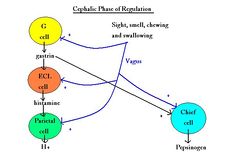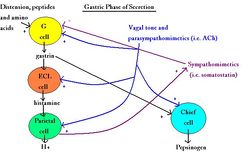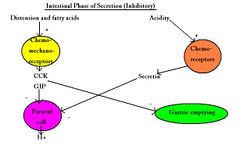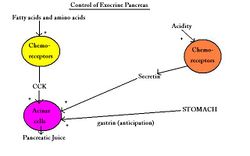Difference between revisions of "Control of Feeding - Anatomy & Physiology"
| (6 intermediate revisions by 2 users not shown) | |||
| Line 1: | Line 1: | ||
| − | |||
==Introduction== | ==Introduction== | ||
Different hormones, neurotransmitters and reflexes are involved in the complicated process of feeding in animals. Secretions and motility of the gastrointestinal tract are stimulated and carefully regulated by numerous factors, including environmental stimuli and the presence of food in different parts of the gastrointestinal tract from the [[Oral Cavity Overview - Anatomy & Physiology|oral cavity]] right through to the intestines. | Different hormones, neurotransmitters and reflexes are involved in the complicated process of feeding in animals. Secretions and motility of the gastrointestinal tract are stimulated and carefully regulated by numerous factors, including environmental stimuli and the presence of food in different parts of the gastrointestinal tract from the [[Oral Cavity Overview - Anatomy & Physiology|oral cavity]] right through to the intestines. | ||
| − | When a harmful substance is ingested the body acts to eliminate it in different ways to prevent the animal becoming ill, for example, through [[ | + | When a harmful substance is ingested the body acts to eliminate it in different ways to prevent the animal becoming ill, for example, through [[Control of Feeding - Anatomy & Physiology#The Vomit Reflex|vomiting]] and [[Diarrhoea|diarrhoea]]. If one or more of the pathways in controlling feeding is damaged or inhibited, then problems such as obesity occurs. |
==Feeding Methods== | ==Feeding Methods== | ||
| − | There are a number of feeding methods, including | + | There are a number of feeding methods, including; Absorption over the body surface, filter feeding, mucous trapping, fluid feeding, piercing and sucking, cutting and biting, seizing prey, the use of jaws, [[:Category:Teeth - Anatomy & Physiology|teeth]], [[The Integument of Exotic Species - Anatomy & Physiology#The Beak|beaks]] and the use of toxins. |
==Functions of the GIT== | ==Functions of the GIT== | ||
| − | The main function of the GIT is to | + | The main function of the GIT is to efficently breakdown feed to the essential nutrients that can then be absorbed. The GIT then acts to propell the waste fed material out of the body. The following functions constitute this main function; The secretion of enzymes and co-factors for digestion including water, ions and mucous; Motility for forward propulsion, mechanical breakdown, mixing of ingesta and sphincter tone; Migrating myoelectric complex to prevent debris accumulation; Peristalsis; Haustration; Segmental motility; Blood flow to muscles, submucosa and epithelial surfaces to sustain secretion, motility and the uptake of products of digestion and growth and repair. |
| − | |||
| − | |||
| − | |||
| − | |||
| − | |||
| − | |||
| − | |||
==Control of the GIT== | ==Control of the GIT== | ||
| − | Endocrine hormones are released into the circulation by cells within the GIT or an accessory organ; paracrine mediators are released by cells within the tract and diffuse locally to act on | + | Endocrine hormones are released into the circulation by cells within the GIT or an accessory organ; paracrine mediators are released by cells within the tract and diffuse locally to act on neighbouring target cells; neurotransmitters from nerves and other cells can be used and the autonomic nervous system is superimposed over the local control. |
==Control of Motility== | ==Control of Motility== | ||
| Line 29: | Line 21: | ||
The control of motility is intrinsic. It uses muscle pacemaker cells (Cajal cells) to set a basic electric rhythm (BER) of 3-20 per minute. It passes through gap junctions and an action potential is created, producing a slow wave of contraction. The likelihood of an action potential is increased through the stretch of food in the lumen and chemical food stimulation. | The control of motility is intrinsic. It uses muscle pacemaker cells (Cajal cells) to set a basic electric rhythm (BER) of 3-20 per minute. It passes through gap junctions and an action potential is created, producing a slow wave of contraction. The likelihood of an action potential is increased through the stretch of food in the lumen and chemical food stimulation. | ||
| − | Endocrine, paracrine or neural signals enter the enteric nervous system via sensory neurones. The neurons interact with plexuses in the GIT wall. The '''myenteric plexus''' controls muscle movement and the '''submucosa plexus''' controls secretion and blood flow. The | + | Endocrine, paracrine or neural signals enter the enteric nervous system via sensory neurones. The neurons interact with plexuses in the GIT wall. The '''myenteric plexus''' controls muscle movement and the '''submucosa plexus''' controls secretion and blood flow. The 2 plexuses are connected by interneurones to co-ordinate control. The autonomic nervous system is superimposed. |
| − | '''Excitatory neurotransmitters''' are '''parasympathomimetic'''. They include | + | '''Excitatory neurotransmitters''' are '''parasympathomimetic'''. They include; ACh (muscarinic M1 and M2), Serotonin and Substance P. |
| − | '''Inhibitory neurotransmitters''' are '''sympathomimetic'''. They include | + | '''Inhibitory neurotransmitters''' are '''sympathomimetic'''. They include; Vasoactive intestinal polypeptide (VIP), Nitric oxide (NO), ATP and Enkephalins. |
==Control of GIT Secretions== | ==Control of GIT Secretions== | ||
| − | The presence of food in the GIT is detected by open chemoreceptors. Signals to the endocrine cells or via the | + | The presence of food in the GIT is detected by open chemoreceptors. Signals to the endocrine cells or via the ANS releases gastrointestinal peptide hormones . These hormones act to promote secretion, provide negative feedback or affect motility. Closed mechanoreceptors also act to alter secretions. Conditioned (associative) and unconditioned responses act via the ANS. |
| Line 65: | Line 57: | ||
[[Image:Cephalic phase of secretion diagram.jpg|thumb|right|250px|Cephalic phase of secretion - Copyright RVC 2008]] | [[Image:Cephalic phase of secretion diagram.jpg|thumb|right|250px|Cephalic phase of secretion - Copyright RVC 2008]] | ||
| − | This | + | This pahse is an unconditioned reflex. It is stimulated by the sight, smell and taste of food. It involves the Vagus nerve ([[Cranial Nerves - Anatomy & Physiology|CN X]]) and parasympathetic fibres that synapse in the submucosal plexus. [[Endocrine System - Gut - Anatomy & Physiology|Gastrin]] is secreted from the endocrine cells in the pyloric mucosa. Postganglionic fibres activate chief, parietal, mucous and G cells. Histamine is secreted from paracrine action. There is an increase in [[Monogastric Stomach - Anatomy & Physiology|stomach]] motility by release of hydrochloric acid and pepsinogen. It is a short phase and overlaps with the gastric phase of secretion. It is inhibited by stress and increased by aggression. |
[[Image:gastric control of secretion diagram.jpg|thumb|right|250px|Gastric control of secretion - Copyright RVC 2008]] | [[Image:gastric control of secretion diagram.jpg|thumb|right|250px|Gastric control of secretion - Copyright RVC 2008]] | ||
===Gastric=== | ===Gastric=== | ||
| − | Chemical and mechanical receptors in the [[Monogastric Stomach - Anatomy & Physiology|stomach]] respond to stretch and chemical stimulation by an increase in the pH of gastric contents. It is a response to undigested materials, especially proteins. Histamine and [[Gut | + | Chemical and mechanical receptors in the [[Monogastric Stomach - Anatomy & Physiology|stomach]] respond to stretch and chemical stimulation by an increase in the pH of gastric contents. It is a response to undigested materials, especially proteins. Histamine and [[Endocrine System - Gut - Anatomy & Physiology|gastrin]] are released. It is a negative feedback loop by sympathomimetic somatostatin released by paracrine method to inhibit [[Endocrine System - Gut - Anatomy & Physiology|gastrin]] secretion (when pH falls below 3). The submucosal and myenteric plexuses are activated in vagus reflex arcs causing the postganglionic release of ACh at parietal cells. The neural response and presence of peptides in chyme stimulates gastrin release. Parietal and chief cells stimulate via gastrin acting in the bloodstream. It is a long response. |
[[Image:Intestinal control of secretion diagram.jpg|thumb|right|250px|Intestinal control of secretion - Copyright RVC 2008]] | [[Image:Intestinal control of secretion diagram.jpg|thumb|right|250px|Intestinal control of secretion - Copyright RVC 2008]] | ||
| Line 76: | Line 68: | ||
===Intestinal=== | ===Intestinal=== | ||
| − | Chyme in the [[Duodenum - Anatomy & Physiology|duodenum]] inhibits acid secretion and motility by decreasing the [[Monogastric Stomach - Anatomy & Physiology|stomach]] distension and increasing the stretch of the [[Duodenum - Anatomy & Physiology|duodenum]] leading to the enterogastric reflex. A drop in pH below 4.5 causes release of secretin which inhibits parietal and chief cells and stimulates buffer release from the [[Pancreas - Anatomy & Physiology|pancreas]]. Chyme causes the release of secretin, [[Gut | + | Chyme in the [[Duodenum - Anatomy & Physiology|duodenum]] inhibits acid secretion and motility by decreasing the [[Monogastric Stomach - Anatomy & Physiology|stomach]] distension and increasing the stretch of the [[Duodenum - Anatomy & Physiology|duodenum]] leading to the enterogastric reflex. A drop in pH below 4.5 causes release of secretin which inhibits parietal and chief cells and stimulates buffer release from the [[Pancreas - Anatomy & Physiology|pancreas]]. Chyme causes the release of secretin, [[Endocrine System - Gut - Anatomy & Physiology|GIP]] and [[Endocrine System - Gut - Anatomy & Physiology|CCK]] decreasing gastric sectretions and motility. |
[[Image:Pancreatic control of secretion diagram.jpg|thumb|right|250px|Pancretic control of secretion - Copyright RVC 2008]] | [[Image:Pancreatic control of secretion diagram.jpg|thumb|right|250px|Pancretic control of secretion - Copyright RVC 2008]] | ||
===Pancreatic=== | ===Pancreatic=== | ||
| − | Involves [[Gut | + | Involves [[Endocrine System - Gut - Anatomy & Physiology|CCK]], secretin and [[Endocrine System - Gut - Anatomy & Physiology|Gastrin]]. Parasympathetic stimulation during cephalic and gastric phases. Negative feedback occurs from paracrine sympathomimetics (somatostatin and enkephalins). |
===Biliary=== | ===Biliary=== | ||
| − | [[Gut | + | [[Endocrine System - Gut - Anatomy & Physiology|CCK]] empties the [[Gall Bladder - Anatomy & Physiology|gall bladder]] and secretin stimulates hydrogencarbonate ions from the bile duct. |
===Small Intestinal=== | ===Small Intestinal=== | ||
| − | Involves secretin, [[Gut | + | Involves secretin, [[Endocrine System - Gut - Anatomy & Physiology|GIP]] and [[Endocrine System - Gut - Anatomy & Physiology|Gastrin]]. Contolled by vagal tone and the parasympathomimetic reflex. |
==Neuroendocrine Regulation of Feeding== | ==Neuroendocrine Regulation of Feeding== | ||
| − | The [[Hypothalamus - Anatomy & Physiology|hypothalamus]] is the critical region of feeding control. The major hypothalamic nuclei involved are; [[Hypothalamus - Anatomy & Physiology#Nuclei| | + | The [[Hypothalamus - Anatomy & Physiology|hypothalamus]] is the critical region of feeding control. The major hypothalamic nuclei involved are; [[Hypothalamus - Anatomy & Physiology#Nuclei|Arcuate]], [[Hypothalamus - Anatomy & Physiology#Nuclei|Ventromedial hypothalamus]], [[Hypothalamus - Anatomy & Physiology#Nuclei|Dorsomedial hypothalamus]], [[Hypothalamus - Anatomy & Physiology#Nuclei|Lateral hypothalamus]] and [[Hypothalamus - Anatomy & Physiology#Nuclei|Paraventricular hypothalamus]]. |
===Gut Peptides=== | ===Gut Peptides=== | ||
| + | |||
{| style="width:75%; height:300px" border="1" | {| style="width:75%; height:300px" border="1" | ||
| Line 193: | Line 186: | ||
'''Click here for more information on [[Vomiting#The Vomit Reflex|The Vomit Reflex]]'''. | '''Click here for more information on [[Vomiting#The Vomit Reflex|The Vomit Reflex]]'''. | ||
| − | |||
[[Category:Feeding Control]] | [[Category:Feeding Control]] | ||
| − | [[Category: | + | [[Category:To Do - AimeeHicks]] |
Revision as of 10:54, 10 September 2010
Introduction
Different hormones, neurotransmitters and reflexes are involved in the complicated process of feeding in animals. Secretions and motility of the gastrointestinal tract are stimulated and carefully regulated by numerous factors, including environmental stimuli and the presence of food in different parts of the gastrointestinal tract from the oral cavity right through to the intestines.
When a harmful substance is ingested the body acts to eliminate it in different ways to prevent the animal becoming ill, for example, through vomiting and diarrhoea. If one or more of the pathways in controlling feeding is damaged or inhibited, then problems such as obesity occurs.
Feeding Methods
There are a number of feeding methods, including; Absorption over the body surface, filter feeding, mucous trapping, fluid feeding, piercing and sucking, cutting and biting, seizing prey, the use of jaws, teeth, beaks and the use of toxins.
Functions of the GIT
The main function of the GIT is to efficently breakdown feed to the essential nutrients that can then be absorbed. The GIT then acts to propell the waste fed material out of the body. The following functions constitute this main function; The secretion of enzymes and co-factors for digestion including water, ions and mucous; Motility for forward propulsion, mechanical breakdown, mixing of ingesta and sphincter tone; Migrating myoelectric complex to prevent debris accumulation; Peristalsis; Haustration; Segmental motility; Blood flow to muscles, submucosa and epithelial surfaces to sustain secretion, motility and the uptake of products of digestion and growth and repair.
Control of the GIT
Endocrine hormones are released into the circulation by cells within the GIT or an accessory organ; paracrine mediators are released by cells within the tract and diffuse locally to act on neighbouring target cells; neurotransmitters from nerves and other cells can be used and the autonomic nervous system is superimposed over the local control.
Control of Motility
The control of motility is intrinsic. It uses muscle pacemaker cells (Cajal cells) to set a basic electric rhythm (BER) of 3-20 per minute. It passes through gap junctions and an action potential is created, producing a slow wave of contraction. The likelihood of an action potential is increased through the stretch of food in the lumen and chemical food stimulation.
Endocrine, paracrine or neural signals enter the enteric nervous system via sensory neurones. The neurons interact with plexuses in the GIT wall. The myenteric plexus controls muscle movement and the submucosa plexus controls secretion and blood flow. The 2 plexuses are connected by interneurones to co-ordinate control. The autonomic nervous system is superimposed.
Excitatory neurotransmitters are parasympathomimetic. They include; ACh (muscarinic M1 and M2), Serotonin and Substance P.
Inhibitory neurotransmitters are sympathomimetic. They include; Vasoactive intestinal polypeptide (VIP), Nitric oxide (NO), ATP and Enkephalins.
Control of GIT Secretions
The presence of food in the GIT is detected by open chemoreceptors. Signals to the endocrine cells or via the ANS releases gastrointestinal peptide hormones . These hormones act to promote secretion, provide negative feedback or affect motility. Closed mechanoreceptors also act to alter secretions. Conditioned (associative) and unconditioned responses act via the ANS.
| Control Method | Neural | Endocrine |
|---|---|---|
| Saliva | Yes | No |
| Stomach | Yes | Yes |
| Small Intestine | No | Yes |
Phases of Gastric Secretion
Cephalic
This pahse is an unconditioned reflex. It is stimulated by the sight, smell and taste of food. It involves the Vagus nerve (CN X) and parasympathetic fibres that synapse in the submucosal plexus. Gastrin is secreted from the endocrine cells in the pyloric mucosa. Postganglionic fibres activate chief, parietal, mucous and G cells. Histamine is secreted from paracrine action. There is an increase in stomach motility by release of hydrochloric acid and pepsinogen. It is a short phase and overlaps with the gastric phase of secretion. It is inhibited by stress and increased by aggression.
Gastric
Chemical and mechanical receptors in the stomach respond to stretch and chemical stimulation by an increase in the pH of gastric contents. It is a response to undigested materials, especially proteins. Histamine and gastrin are released. It is a negative feedback loop by sympathomimetic somatostatin released by paracrine method to inhibit gastrin secretion (when pH falls below 3). The submucosal and myenteric plexuses are activated in vagus reflex arcs causing the postganglionic release of ACh at parietal cells. The neural response and presence of peptides in chyme stimulates gastrin release. Parietal and chief cells stimulate via gastrin acting in the bloodstream. It is a long response.
Intestinal
Chyme in the duodenum inhibits acid secretion and motility by decreasing the stomach distension and increasing the stretch of the duodenum leading to the enterogastric reflex. A drop in pH below 4.5 causes release of secretin which inhibits parietal and chief cells and stimulates buffer release from the pancreas. Chyme causes the release of secretin, GIP and CCK decreasing gastric sectretions and motility.
Pancreatic
Involves CCK, secretin and Gastrin. Parasympathetic stimulation during cephalic and gastric phases. Negative feedback occurs from paracrine sympathomimetics (somatostatin and enkephalins).
Biliary
CCK empties the gall bladder and secretin stimulates hydrogencarbonate ions from the bile duct.
Small Intestinal
Involves secretin, GIP and Gastrin. Contolled by vagal tone and the parasympathomimetic reflex.
Neuroendocrine Regulation of Feeding
The hypothalamus is the critical region of feeding control. The major hypothalamic nuclei involved are; Arcuate, Ventromedial hypothalamus, Dorsomedial hypothalamus, Lateral hypothalamus and Paraventricular hypothalamus.
Gut Peptides
| Peptide | Site of Release | Effect on Feeding |
|---|---|---|
| CCK | Duodenum | Reduces food intake |
| Ghrelin | Gastric fundus | Increases food intake |
| GLP-2 | Intestine | Reduces food intake |
| Motilin | Small intestine | Indirectly inhibits food intake |
| Oxyntomodulin | large intestine | Inhibits food intake |
| Pancreatic Polypeptide | Pancreas | Inhibits food intake |
| PYY3-36 | Intestine | Inhibits food intake |
| Somatostatin | Pancreas | Inhibits food intake |
Other Peptides
| Peptide | Site of Release | Effect on Feeding |
|---|---|---|
| Leptin | Adipocyte | Reduces food intake |
| NPY | Arcuate nucleus | Increases food intake |
| Agrp | Arcuate nucleus | Increases food intake |
| MCH | Lateral hypothalamus | Increases food intake |
| Orexins | Lateral hypothalamus | Increases food intake |
| CART | Arcuate nucleus | Inhibits food intake |
| α MSH | Arcuate nucleus | Inhibits food intake |
| Bdnf | Ventromedial nucleus | Inhibits food intake |
| Serotonin | Brainstem | Inhibits food intake |
| Cannabinoids | CNS | Increases food intake |
Species Differences
Equine
The anatomy of the equine stomach, the close proximity of the exiting duodenum and the entering oesophagus along with the well developed cardiac sphincter, make it difficult for the horse to vomit. However on rare occasions it does occur.
Click here for more information on The Vomit Reflex.



